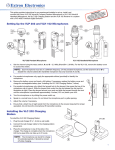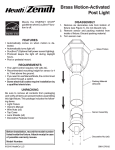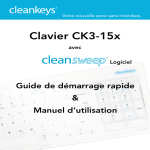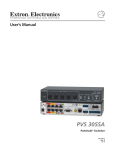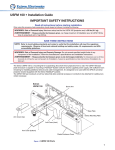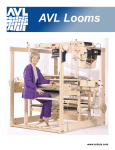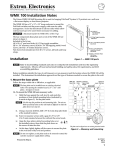Download PDF - Extron Electronics
Transcript
PVM 220 • Installation Guide The Extron PVM 220 is an enclosure for the safe mounting of PoleVault® system devices in the plenum area of a suspended ceiling. The main enclosure will fit on a 24 x 24 inch framed tile space and is used to mount a PoleVault System switcher and the power supply, and other optional Extron AV devices. The PVM 220 comes with a detachable device mounting plate that makes installation of PoleVault devices and accessories easier. E VE L PEAK ITY SITIV L NORM LE DIO LIFT AU VOICE L PEAK AL NORM 3 1 5 X AU FIG SE LE CT 2 4 IN PU TS AU DI O INPU T SIGNA SIGNA AL AD SEN JU ST PAGI SENS NG OR PO PV LEV S AU 40 LT 5S SW A ITC IP HE R Device Mounting Plate CON Suitable for use in environmental air space in accordance with Section 300-22(C) of the National Electrical Code, and Sections 2-128, 12-010(3) and 12-100 of the Canadian Electrical Code, Part 1, CSA C22.1. The product has been additionally investigated to UL 2043, "Fire Test for Heat and Visible Smoke Release for Discrete Products and Their Accessories Installed in Air-Handling Spaces ". PVM 220 Enclosure R The PVM 220 is UL Listed for use in plenum airspaces: meets UL 2043 for heat and smoke release. Access Door Figure 1. PVM 220 Installed (Access Door Open) NOTES: • The following products are approved for use in the UL 2043 rated Extron PVM 220 enclosure as part of the Extron PlenumVault System: • PVS 305SA IP PoleVault Switcher • PVS 405D PoleVault Switcher • CC 100C Network Codec • IPL 250 IP Link Controller • SW2 HDMI Switcher In addition, any Extron product that has been individually tested and UL 2043 approved can also be used. Contact Extron for a complete list of plenum rated products. • The PoleVault switcher and other AV devices are not supplied with the PVM 220. • For full installation, configuration, menus, connector wiring, and operation details of the PoleVault switcher, see the relevant PoleVault System Installation Guide, available at www.extron.com. Pre-installation Read all instructions before installing this enclosure. IMPORTANT INSTRUCTIONS: • Installation of this product must be done by a qualified, professional installer. • Installation of this product (including the wiring of devices) must meet national electrical codes, and local building standards and codes. • A readily accessible disconnect device shall be incorporated in the building installation wiring. • Building installation wiring to be protected by a UL Listed circuit breaker rated 15 A or less. • Observe all local and national building and safety codes, UL requirements, and ADA Accessibility Guidelines. Identify the location where the PVM 220 will be installed. Typically this would be a T-grid suspended ceiling with minimum 24 x 24 inch tiles, close to the display device location. Take into consideration access to a power source and the proximity of other utilities (gas, water, fire sprinklers and so forth). Also consider the other devices that are associated with the PoleVault switcher, such as speakers, input and output devices, wallplates and control devices, and the facility communication systems (such as a department information system). PVM 220 Features The PVM 220 is comprised of a main enclosure, an access door, and a device mounting plate (see figure 1). The device mounting plate fits onto the door frame and allows access to the devices and cables when the door is open. Additional installation hardware is needed for this installation, and it should be supplied by the installer. Included hardware for installation: For Enclosure Installation Size and (Quantity) For Device Mounting (Quantity) Suspension cables 15 feet x Á inch dia. (4) #4-40 device mounting screws (10) Cable locks (4) Zip ties long (4), short (15) Lag eye bolts 1¼ x ¼ inch (4) Signal cable tie downs (15) Cable clamps 1 inch (1), ¾ inch (2) 1 PVM 220 • Installation Guide (Continued) Installation a. Remove this screw on the right and left sides of the mounting plate. Step 1 — Remove device mounting plate from the access door. a. Door Tether “T” Open the access door and unscrew the two Phillips screws that are located in the bottom corners of the plate (left and right sides), near the door latches and door tether "T." NOTE: Do not remove any of the screws located below the hinges. Bottom of Door (inside right corner view) b. Swing the bottom of the plate up to separate it from the door frame, then slide the plate to the right until it becomes free of the hinge pins on the door frame. b. Swing the mounting plate out from the door frame and slide the plate to the right, off the hinge pins. Retain the device mounting plate for later use (see step 6). Figure 2. Remove the mounting plate from the door. Step 2 — Remove ceiling tile and install suspension cables. For threaded rod installation see step 3, second section. a. At the location where the PVM 220 is to be installed, remove the ceiling tile and mark the T-grid for that tile then remove the adjacent tiles to make working on the grid easier. b. At an approximate angle of 10 degrees out from each corner of where the PVM 220 will be installed, mark and drill four holes in the structural ceiling for the suspension cable anchors. c. Figure 3. Tie the cable to the ceiling anchor. Screw a lag eye bolt (or an appropriate anchor) into each hole. d. Thread the looped end of the suspension cable though the bolt eyehole, Thread the cable down through the cable lock, through the hole on the frame of the enclosure and back up through the lock. pass the rest of the cable through the loop and tighten. Allow each cable to hang down. Step 3 —Suspend the main PVM 220 enclosure from the ceiling. a. Lift and place the PVM 220 enclosure carefully onto the T-grid so that it sits squarely on the grid. Locking Pin Cable Lock b. Holding a cable lock, press the locking pin down (following arrow directions) and pass the loose end of one the cables down through the large hole in the lock. Continue to push the cable down until about 12-15 inches of cable has exited the lock. c. Pass the loose end of the cable directly through the corner hole on the PVM 220 enclosure and then back up through the other large hole in the lock. Pass at least six inches of cable out through the top of the lock. d. Repeat for each corner. e. Adjust the cable tension through all locks, making each cable taut without lifting the PVM 220 off the T-grid. Figure 4. Secure the PVM 220 to the ceiling with cable on all corners. 2 Product Category For threaded rod installation NOTES: • … inch or à inch diameter threaded rods are recommended to be used for installing this product. Insert threaded rods through holes on the ends of the mounting plate. • The threaded rod should be properly secured to the ceiling structure. For example, properly fasten a unistrut to the ceiling structure and attach threaded rods using nuts and washers. Secure the frame to the structural ceiling using threaded rods. To do this: a. Attach four rods to the support structure by using, for example a unistrut, one over each corner of the PVM 220 installation location. b. Attach a rod to each corner securing point of the PVM 220 with nuts and washers (see figure 5, at right). c. Adjust all the nuts to secure the PVM 220 to the ceiling, keeping it level and without lifting the unit from the T-grid. Attach washers and nuts and secure. Figure 5. Secure the PVM 220 to the ceiling with threaded rod. Step 4 — Run AC power wiring to the AC module in the PVM 220. If power is not available close to the installation location, install a junction box or power source at the area. NOTES: • This must be done by a qualified electrician and must meet local and national electrical, building and safety codes and all the regulatory requirements. See the Important Instructions on page 1. • Use metal conduit only to run wire to the AC module. • Do not run power cable in the same conduit as signal cables. • Use 14 AWG gauge solid copper wire only, as required by the installed power receptacles. Run the power cable through metal conduit and wire it into the PVM 220 power module. To do this: a. Unscrew the two center screws (left and right side) of the power inlet/control panel and remove from the enclosure (see figure 6). a. Remove power module from the PVM 220 enclosure. b. Unscrew the two screws on the corners and detach the outer cover. c. Attach the metal conduit to the outer cover. NOTES: • Remove only the knockouts that are to be used for cabling. Leave intact the unused knockouts. • The three knockout sizes are Œ inch to – inch, – to 1 inch, and 1 to 1… inch. d. Run the wires through the conduit and connect to the AC receptacles. e. Reassemble the power module. f. Reattach the module to the enclosure. NOTE: The power module outlets must be used to power installed AV devices only. 1/2" Conduit Knockout b. Remove the cover from power module. c. Attach a metal conduit. Figure 6. Remove the power module from the enclosure to attach the metal conduit. 3 PVM 220 • Installation Guide (Continued) Step 5 — Run signal and control cables to the PVM 220. Run the signal and control cables either into cable clamps or through conduit attached to the PVM 220 enclosure (see figure 7). 1. Push the cable clamp into the knockout from inside the enclosure. To install a cable clamp on the enclosure: a. Select a suitable sized cable clamp for the quantity and thickness of cable to be fed into the enclosure. See the note on page 3, Step 4 for knockout sizes. b. Identify the most suitable cable entry point and remove one or more knockouts as needed. NOTE: Remove only the knockouts that are to be used for cabling. Leave intact the unused knockouts. c. Remove the large nut from the back of the cable clamp and insert the clamp into the enclosure knockout from the inside. 2. Attach the nut from the outside of the enclosure. d. Place the nut on the clamp and tighten to secure. e. f. Pass the cables through the clamp into the enclosure. Leave enough cable slack at the PVM 220 to ensure cable connection to any device is maintained when the access door is open. Figure 7. Install a cable clamp on the PVM 220 enclosure (viewed from above). Tighten down the cable grip until the cables are held firmly. Avoid damaging or bending cables at too sharp an angle. NOTE: See the PoleVault System Installation Guide for full cable connection details. Step 6 — Install devices onto the device mounting plate. NOTE: The maximum door load is 15 lbs (6.8 kg). Mount the PoleVault switcher with the front panel facing outwards in the marked location. Mount other optional devices as desired. To mount the devices and accessories: a. Carefully align the switcher with the appropriate holes in the marked location (indicated by arrows on the mounting plate). R CO NFI G SE LE CT INP 1 UT S 2 b. Secure the switcher with the supplied #4-40 » inch mounting 3 4 AU DI 5 O X AU INPU T screws, tightening each one until snug. Do not overtighten. Mount the power supply onto the device mounting plate in the marked location (indicated by arrows on the mounting plate), using the supplied screws. NOTE: Replacement power supplies must be either the equivalent Extron power supply, or a UL Listed NEC Class 2 power supply. PEAK AL AU DIO SIGN AL VOIC ELIFT LE VE L AD JU PEAK ST NORM AL SIGN AL PAG SENING SOR SEN SITI PV VITY PO LE S VA 40 UL 5S T SW A ITC IP HE R E c. NORM Device Mounting Plate PoleVault Switcher Power Supply Figure 8. Install the devices onto the mounting plate. 21.5" (54.6 cm) d. Mount any other devices following the procedures in the supplied device guide. Step 7 — Cut and install the ceiling tile in the access door. NOTES: • The door can accept a ceiling tile thicknesses of Œ-1… inches. Check the tile thickness before cutting. Cut the ceiling tile to 22 x 21.5 inches and use that part for insertion into the access door. 22.0" (55.9 cm) • If the ceiling tiles have a specific pattern direction, ensure the overall pattern direction is maintained when cutting and fitting the cut tile insert into the access door. a. Mark the dimensions (22 inches by 21.5 inches) for the PVM 220 access door on the installation tile and cut the tile to size. b. With the access door open, insert the cut ceiling tile into the door frame (see figure 10, on page 5). Bottom of Door (Door Locks) Example: 24 x 24 inch Ceiling Tile Figure 9. Cut the ceiling tile for insertion into the 4 access door. Product Category Step 8 — Install the device mounting plate onto the access door. To fit the mounting plate and devices on the access door: a. Align and slide the device mounting plate onto the two hinge pins located at the top of the door frame. PVM 220 Enclosure b. Secure the plate into place with the two mounting plate screws, located at the bottom of the door frame. Device Mounting Plate Hinges Device Mounting Plate Hinge Pins Device Mounting Plate (with devices installed) Y ITIVIT L PEAK NORM LEV DIO LIFT VOICE AU NORM L PEAK AL SIGNA T INPU DIO 5 X AU AU S INP UT 3 4 1 2 T SE LEC FIG CON R PoleVault Switcher (front panel facing down) SIGNA AL EL SENS AD JUS T PAGIN SENS G OR PO PV LEV S AUL 40 T 5S SW A ITC IP HER E Door Frame Device Mounting Plate Screws Ceiling Tile Insert Figure 10. Insert the ceiling tile and attach the device mounting Step 9 — Connect the cables to the devices. plate to the access door (as viewed from below). NOTES: • See the PoleVault System Installation Guide or the relevant PoleVault switcher user guide for connecting cables and devices to the PVS device. • For cable connections to optional devices see the relevant device guide or manual. Connect the fan cable (already installed in the enclosure) to the switcher power supply. Connect and dress the other cables as needed, providing enough slack to open and close the access door. Step 10 — Verify and configure the setup. Turn on the power to all the devices. Verify and configure the system. See the PVS 405D User Guide, or PVS 305SA IP User Guide available at www.extron.com for full details. Step 11 — Attach the door tether to the door. The PVM 220 enclosure has a coiled door tether installed on the right side of the enclosure (when viewed from the front). After the device mounting plate is installed, the tether should be attached to the door to ensure safety when the door is opened. Push the tether loop completely over the T tab on the door. To attach the tether to the door: a. With the door fully open, locate the door tether attached within the enclosure. The coiled tether has a looped end to be attached to the door. b. In the lower corners of the door locate the cutout with a "T" shaped metal tab (see figure 11). c. Stretch the tether and close up the door until the loop on the tether can be carefully slid over the "T" tab on the door. Ensure the loop is completely over the "T". d. Carefully lower the door to the full extent of the tether to ensure it functions correctly. Figure 11. Attach the Tether to the Door (as viewed from inside enclosure). 5 PVM 220 • Installation Guide (Continued) Step 12 — Secure the door latches. Both door latches can be made secure so the door cannot be opened accidentally or inadvertently. To secure the latches close the door and tighten down the small set screws onto the latch (see figure 12). For full safety secure both latches. To secure the latch from opening tighten down the set screw onto the latch. Figure 12. Secure the door latches (side of door view). PVM 220 Enclosure Dimensions 6.34" (16.10 cm) 23.75" (60.33 cm) 24.09" (61.20 cm) 23.75" (60.33 cm) 6.34" (16.10 cm) Figure 13. Enclosure Dimensions 6 Extron Headquarters +1.800.633.9876 (Inside USA/Canada Only) Extron Asia +65.6383.4400 Extron China +86.21.3760.1568 Extron Korea +82.2.3444.1571 Extron Europe +31.33.453.4040 Extron Japan +81.3.3511.7655 Extron Middle East +971.4.299.1800 Extron India +91.80.3055.3777 © 2013 Extron Electronics — All rights reserved. All trademarks mentioned are the property of their respective owners. www.extron.com 68-2383-01 Rev. A 10 13






